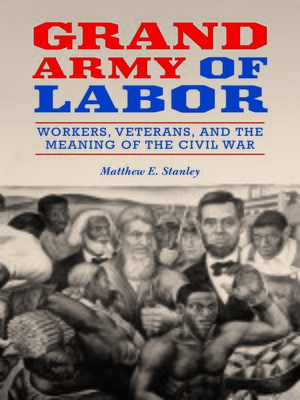Grand Army of Labor
ebook ∣ Workers, Veterans, and the Meaning of the Civil War · Working Class in American History
By Matthew E. Stanley

Sign up to save your library
With an OverDrive account, you can save your favorite libraries for at-a-glance information about availability. Find out more about OverDrive accounts.
Find this title in Libby, the library reading app by OverDrive.



Search for a digital library with this title
Title found at these libraries:
| Library Name | Distance |
|---|---|
| Loading... |
From the Gilded Age through the Progressive era, labor movements reinterpreted Abraham Lincoln as a liberator of working people while workers equated activism with their own service fighting for freedom during the war. Matthew E. Stanley explores the wide-ranging meanings and diverse imagery used by Civil War veterans within the sprawling radical politics of the time. As he shows, a rich world of rituals, songs, speeches, and newspapers emerged among the many strains of working class cultural politics within the labor movement. Yet tensions arose even among allies. Some people rooted Civil War commemoration in nationalism and reform, and in time, these conservative currents marginalized radical workers who tied their remembering to revolution, internationalism, and socialism.
An original consideration of meaning and memory, Grand Army of Labor reveals the complex ways workers drew on themes of emancipation and equality in the long battle for workers' rights.
| Cover Title Page Copyright Contents Foreword Acknowledgments Introduction: A Second Great Emancipator Chapter 1. King Labor: Workers Imagine Emancipation beyond Equality Chapter 2. Southern Palm, Northern Pine: Greenbackers and the Reconciliation of Class Chapter 3. Against Masters and Money Power: The Knights of Labor and Wage Slavery Chapter 4. The Red Flag of Emancipation: Socialism and Revolutionary Memory Chapter 5. The Blue-Gray Campaign: Populism and White Reunion Chapter 6. Citadel of Labor: The American Federation of Labor and Reformist Memory Chapter 7. The Blue and the Gray and the Red: The Rise and Repression of Proletarian Memory Epilogue: Resurrecting John Brown's Body Notes Bibliography Index Back cover |"This book is a must for those who would strive to replace marble men with stories of people who lived and died fighting against monopoly, white supremacy, inequality, militarism, convict labor, and a growing internal empire." —Journal of American History"As Matthew Stanley shows, the foot-soldiers in Grand Army of Labor lost many of their initial electoral battles. Yet pioneering efforts ultimately succeeded in popularizing the idea that veterans' benefits were a good working model for more expansive social welfare programs, benefiting all U.S. workers and their families." —Against the Current
"Stanley's outstanding study reminds us of the power of symbols—including popular images of antislavery leaders, such as Abraham Lincoln, and abolitionist martyrs, such as John Brown—as well as incomplete and skewed historical representations, such as the Lost Cause." —Journal of the Civil War Era
|Matthew E. Stanley is an associate professor of history at Albany State University. He is the author of The Loyal West: Civil War and Reunion in Middle America.







